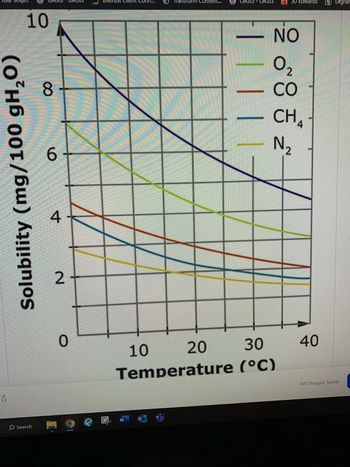
Chemistry: Principles and Reactions
8th Edition
ISBN: 9781305079373
Author: William L. Masterton, Cecile N. Hurley
Publisher: Cengage Learning
expand_more
expand_more
format_list_bulleted
Concept explainers
Question

Transcribed Image Text:Question 3
What is the solubility of nitrogen gas, in mg/100 g H₂O at 25°C?

Transcribed Image Text:Solubility (mg/100 gH₂O)
O<
10
O Search
∞
CO
4
~
0
61
1
licerin
အားးး
20
30
Temperature (°C)
10
Edwards
26852
40
Legran
All Changes Saved
Expert Solution
This question has been solved!
Explore an expertly crafted, step-by-step solution for a thorough understanding of key concepts.
This is a popular solution
Trending nowThis is a popular solution!
Step by stepSolved in 2 steps

Knowledge Booster
Learn more about
Need a deep-dive on the concept behind this application? Look no further. Learn more about this topic, chemistry and related others by exploring similar questions and additional content below.Similar questions
- One mole of Na2S is represented as where represents Na and represents S. Complete the picture showing only the sodium and sulfide ions. The water molecules need not be shown. What is the molarity of Na+? of S2-?arrow_forwardThe freezing point of a 0.21 m aqueous solution of H2SO4 is -0.796C. (a) What is i? (b) Is the solution made up primarily of (i) H2SO4 molecules only? (ii) H+ and HSO4- ions? (iii) 2H+ and 1SO42- ions?arrow_forward6-49 A student has a stock solution of 30.0% w/v H2O2 (hydrogen peroxide). Describe how the student should prepare 250 mL of a 0.25% w/v H2O2 solution.arrow_forward
- Graph Table 14.10 shows solubility data that was collectedin an experiment. Plot a graph of the molarity ofKI versus temperature. What is the solubility of KI at55°C?arrow_forwardWhich of the principal characteristics of solutions can we see in the solutions of K2Cr2O7 shown in Figure 11.2?arrow_forwardWhat volume of 0.250 M NaOH is required to react completely with 0.0100 moles of H2SO4? (a) 80.0 mL (b) 60.0 mL (c) 40.0 mL (d) 125 mLarrow_forward
- 6-15 Answer true or false. (a) A solute is the substance dissolved in a solvent to form a solution. (b) A solvent is the medium in which a solute is dissolved to form a solution. (c) Some solutions can be separated into their components by filtration. (d) Acid rain is a solution.arrow_forwardA compound has a solubility in water of 250 mg/L at 25C. Should this compound be characterized as a soluble or insoluble compound at 25C?arrow_forwardA solution is made by dissolving 0.455 g of PbBr2 in 100 g of H2O at 50C. Based on the data in Table 8-1, should this solution be characterized as a. saturated or unsaturated b. dilute or concentratedarrow_forward
- An aqueous solution is 20.0% by mass of sodium thiosulfate pentahydrate, Na2S2O35H2O. What is the molarity of Na2S2O3 in this solution at 20C? The density of this solution at 20C is 1.174g/mL.arrow_forwardThe freezing point of 0.10 M KHSO3 is -0.38C. Which of the following equations best represents what happens when KHSO3 dissolves in water? (a) KHSO3(s)KHSO3(aq) (b) KHSO3(s) K+(aq)+HSO3(aq) (c) KHSO3(s) K+(aq)+SO32(aq)+ H+(aq)arrow_forward6-22 Answer true or false. (a) Water is a good solvent for ionic compounds because water is a polar liquid. (b) Small covalent compounds dissolve in water if they can form hydrogen bonds with water molecules. (c) The solubility of ionic compounds in water generally increases as temperature increases. (d) The solubility of gases in liquids generally increases as temperature increases. (e) Pressure has little effect on the solubility of liquids in liquids. (f) Pressure has a major effect on the solubility of gases in liquids. (g) In general, the greater the pressure of a gas over water, the greater the solubility of the gas in water. (h) Oxygen, O2, is insoluble in water.arrow_forward
arrow_back_ios
SEE MORE QUESTIONS
arrow_forward_ios
Recommended textbooks for you
 Chemistry: Principles and ReactionsChemistryISBN:9781305079373Author:William L. Masterton, Cecile N. HurleyPublisher:Cengage Learning
Chemistry: Principles and ReactionsChemistryISBN:9781305079373Author:William L. Masterton, Cecile N. HurleyPublisher:Cengage Learning Introduction to General, Organic and BiochemistryChemistryISBN:9781285869759Author:Frederick A. Bettelheim, William H. Brown, Mary K. Campbell, Shawn O. Farrell, Omar TorresPublisher:Cengage Learning
Introduction to General, Organic and BiochemistryChemistryISBN:9781285869759Author:Frederick A. Bettelheim, William H. Brown, Mary K. Campbell, Shawn O. Farrell, Omar TorresPublisher:Cengage Learning General, Organic, and Biological ChemistryChemistryISBN:9781285853918Author:H. Stephen StokerPublisher:Cengage Learning
General, Organic, and Biological ChemistryChemistryISBN:9781285853918Author:H. Stephen StokerPublisher:Cengage Learning Chemistry: The Molecular ScienceChemistryISBN:9781285199047Author:John W. Moore, Conrad L. StanitskiPublisher:Cengage LearningChemistry: Matter and ChangeChemistryISBN:9780078746376Author:Dinah Zike, Laurel Dingrando, Nicholas Hainen, Cheryl WistromPublisher:Glencoe/McGraw-Hill School Pub Co
Chemistry: The Molecular ScienceChemistryISBN:9781285199047Author:John W. Moore, Conrad L. StanitskiPublisher:Cengage LearningChemistry: Matter and ChangeChemistryISBN:9780078746376Author:Dinah Zike, Laurel Dingrando, Nicholas Hainen, Cheryl WistromPublisher:Glencoe/McGraw-Hill School Pub Co Chemistry & Chemical ReactivityChemistryISBN:9781337399074Author:John C. Kotz, Paul M. Treichel, John Townsend, David TreichelPublisher:Cengage Learning
Chemistry & Chemical ReactivityChemistryISBN:9781337399074Author:John C. Kotz, Paul M. Treichel, John Townsend, David TreichelPublisher:Cengage Learning

Chemistry: Principles and Reactions
Chemistry
ISBN:9781305079373
Author:William L. Masterton, Cecile N. Hurley
Publisher:Cengage Learning

Introduction to General, Organic and Biochemistry
Chemistry
ISBN:9781285869759
Author:Frederick A. Bettelheim, William H. Brown, Mary K. Campbell, Shawn O. Farrell, Omar Torres
Publisher:Cengage Learning

General, Organic, and Biological Chemistry
Chemistry
ISBN:9781285853918
Author:H. Stephen Stoker
Publisher:Cengage Learning

Chemistry: The Molecular Science
Chemistry
ISBN:9781285199047
Author:John W. Moore, Conrad L. Stanitski
Publisher:Cengage Learning

Chemistry: Matter and Change
Chemistry
ISBN:9780078746376
Author:Dinah Zike, Laurel Dingrando, Nicholas Hainen, Cheryl Wistrom
Publisher:Glencoe/McGraw-Hill School Pub Co

Chemistry & Chemical Reactivity
Chemistry
ISBN:9781337399074
Author:John C. Kotz, Paul M. Treichel, John Townsend, David Treichel
Publisher:Cengage Learning